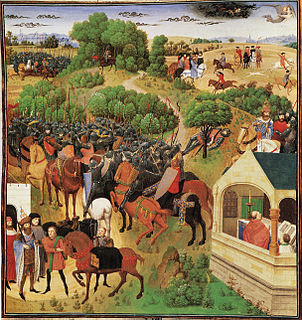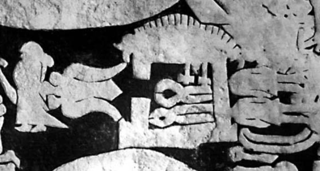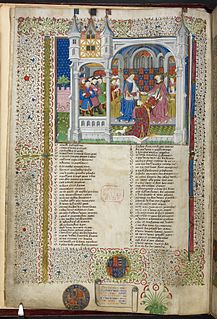
Beowulf is an Old English epic poem in the tradition of Germanic heroic legend consisting of 3,182 alliterative lines. It is one of the most important and most often translated works of Old English literature. The date of composition is a matter of contention among scholars; the only certain dating is for the manuscript, which was produced between 975 and 1025. Scholars call the anonymous author the "Beowulf poet". The story is set in pagan Scandinavia in the 6th century. Beowulf, a hero of the Geats, comes to the aid of Hrothgar, the king of the Danes, whose mead hall in Heorot has been under attack by the monster Grendel. After Beowulf slays him, Grendel's mother attacks the hall and is then defeated. Victorious, Beowulf goes home to Geatland and becomes king of the Geats. Fifty years later, Beowulf defeats a dragon, but is mortally wounded in the battle. After his death, his attendants cremate his body and erect a tower on a headland in his memory.
Old English literature, or Anglo-Saxon literature, encompasses literature written in Old English, in Anglo-Saxon England from the 7th century to the decades after the Norman Conquest of 1066. According to Bede, the 7th century work Cædmon's Hymn is considered as the oldest surviving poem in English. Poetry written in the mid-12th century represents some of the latest post-Norman examples of Old English. For example, The Soul's Address to the Body found in Worcester Cathedral Library MS F. 174 contains only one word of possible Latinate origin, while also maintaining a corrupt alliterative meter and Old English grammar and syntax, albeit in a degenerative state. The Peterborough Chronicle can also be considered a late-period text, continuing into the 12th century. The strict adherence to the grammatical rules of Old English is largely inconsistent in 12th century work – as is evident in the works cited above – and by the 13th century the grammar and syntax of Old English had almost completely deteriorated, giving way to the much larger Middle English corpus of literature.

William Dunbar was a Scottish makar poet active in the late fifteenth century and the early sixteenth century. He was closely associated with the court of King James IV and produced a large body of work in Scots distinguished by its great variation in themes and literary styles. He was likely a native of East Lothian, as assumed from a satirical reference in The Flyting of Dumbar and Kennedie. His surname is also spelt Dumbar.
Poetry took numerous forms in medieval Europe, for example, lyric and epic poetry. The troubadours and the minnesänger are known for their lyric poetry about courtly love.

The chanson de geste is a medieval narrative, a type of epic poem that appears at the dawn of French literature. The earliest known poems of this genre date from the late eleventh and early twelfth centuries, shortly before the emergence of the lyric poetry of the troubadours and trouvères, and the earliest verse romances. They reached their highest point of acceptance in the period 1150–1250.
Occitan literature is a body of texts written in Occitan, mostly in the south of France. It was the first literature in a Romance language and inspired the rise of vernacular literature throughout medieval Europe. Occitan literature's Golden Age was in the 12th century, when a rich and complex body of lyrical poetry was produced by troubadours writing in Old Occitan, which still survives to this day. Although Catalan is considered by some a variety of Occitan, this article will not deal with Catalan literature, which started diverging from its Southern French counterpart in the late 13th century.
Anglo-Norman literature is literature composed in the Anglo-Norman language developed during the period 1066–1204 when the Duchy of Normandy and the Kingdom of England were united in the Anglo-Norman realm.

Jean François Victor Aicard was a French poet, dramatist and novelist.

Vǫlundarkviða is one of the mythological poems of the Poetic Edda. The title is anglicized in various ways, including Völundarkvitha, Völundarkvidha, Völundarkvida, Volundarkvitha, Volundarkvidha and Volundarkvida.

Medieval French literature is, for the purpose of this article, Medieval literature written in Oïl languages during the period from the eleventh century to the end of the fifteenth century.
The Song of Dermot and the Earl is an anonymous Anglo-Norman verse chronicle written in the early 13th century in England. It tells of the arrival of Richard de Clare (Strongbow) in Ireland in 1170, and of the subsequent arrival of Henry II of England. The poem mentions one Morice Regan, secretary to Dairmaid mac Murchadha, king of Leinster, who was eyewitness to the events and may have provided an account to the author.
Anglo-Norman, also known as Anglo-Norman French, was a dialect of Old Norman French that was used in England and, to a lesser extent, elsewhere in Great Britain and Ireland during the Anglo-Norman period.
Ipomedon is a romance composed in Anglo-Norman verse by Hue de Rotelande in the late 12th century at Credenhill near Hereford. In the sequel Protheselaus, which must have been composed slightly later, Hue acknowledges as his patron Gilbert fitzBaderon, lord of Monmouth. Gilbert's death in or just before 1191 gives an approximate terminus ante quem to both romances.

Christ I, is a fragmentary collection of Old English poems on the coming of the Lord, preserved in the Exeter Book. In its present state, the poem comprises 439 lines in twelve distinct sections. In the assessment of Edward B. Irving Jr, "two masterpieces stand out of the mass of Anglo-Saxon religious poetry: The Dream of the Rood and the sequence of liturgical lyrics in the Exeter Book ... known as Christ I".
Guernes de Pont-Sainte-Maxence, also known as Garnier, was a 12th-century French scribe and one of the ten contemporary biographers of Saint Thomas Becket of Canterbury.
Guillaume de Dole is an Old French narrative romance by Jean Renart. Composed in the early 13th century, the poem is 5,656 lines long and is especially notable for the large number of chansons it contains, and for its active female protagonist. The romance incorporates forty-six chansons ; it is the first extant example in French literature of a text that combines narrative and lyric. Its form was quickly imitated, by authors such as Gerbert de Montreuil, and by the end of the 13th century had become canonical.
The "Battle of Brunanburh" is an Old English poem. It is preserved in the Anglo-Saxon Chronicle, a historical record of events in Anglo-Saxon England which was kept from the late ninth to the mid-twelfth century. The poem records the Battle of Brunanburh, a battle fought in 937 between an English army and a combined army of Scots, Vikings, and Britons. The battle resulted in an English victory, celebrated by the poem in style and language like that of traditional Old English battle poetry. The poem is notable because of those traditional elements and has been praised for its authentic tone, but it is also remarkable for its fiercely nationalistic tone, which documents the development of a unified England ruled by the House of Wessex.

Walter of Bibbesworth (1235–1270) was an English knight and Anglo-Norman poet. Documents confirm that he held land in the parish of Kimpton, Hertfordshire at the farm now called Bibbsworth Hall. About 1250 he served in Gascony under the seneschal Nicholas de Molis in the army of the English king Henry III. In 1270/1271 he is believed to have taken part in the Ninth Crusade on the evidence of a tençon or poetic argument between himself and Henry de Lacy, 3rd Earl of Lincoln. In the poem Walter, about to depart for Palestine, teases Henry for staying at home for the love of a certain woman. In fact the young Henry de Lacy, "recently married and with heavy responsibilities at home", did not take part in the Ninth Crusade. Walter went and returned. He was buried early in Edward I's reign at Little Dunmow in Essex.

The Talbot Shrewsbury Book is a very large richly-illuminated manuscript made in Rouen (Normandy) in 1444/5. It was presented by John Talbot, 1st Earl of Shrewsbury to the French princess, Margaret of Anjou, in honour of her betrothal to King Henry VI. It contains a unique collection of fifteen texts in French, including chansons de geste, chivalric romances, treatises on warfare and chivalry, and finally the Statutes of the Order of the Garter. The work is an excellent example of book production in Rouen in the mid-fifteenth century and provides a rare insight into the political views of the English military leader and close confidant of the crown, John Talbot.
The Juvencus Manuscript is one of the main surviving sources of Old Welsh. Unlike much Old Welsh, which is attested in manuscripts from later periods and in partially updated form, the Welsh material in the Juvencus Manuscript was written in the Old Welsh period itself; the manuscript provides the first attestation of many Welsh words.